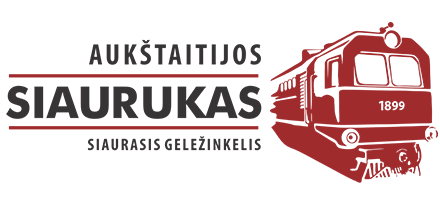History of the Aukštaitija Narrow Gauge Railway
In 1898 Panevėžys become connected to railway, as narrow-gauge railway and station were build. First trains on the new section began running in the fall of 1899. At that time the narrow-gauge railway line had 2 depots – in Švenčionys and in Panevėžys, 15 locomotives, 112 freight wagons, 58 various types of passenger cars, 6 postal wagons and 154 cargo platforms. In 1903, it carried 65,000 tons of cargo and 40,632 passengers.
During the First World War, in 1916 German army built new 600 mm wide sections: Gubernija-Pasvalys and Joniškis-Žeimelis. The construction of new narrow-gauge railway sections took into account areas of intensive agricultural production and areas of intensively exploited forests and promising peatlands. Forest material was mostly transported to Germany at that time.
During the period of independent Lithuania, in 1920–1938, local municipalities made a significant contribution to the development of the narrow-gauge railway network, as they took care of the construction of new narrow-gauge railway branches through their territories, provided calculations of the transportation of goods and products, and arguments for the export and import of various goods. The needs of manors, cooperatives, dairies, etc. were taken into account when constructing narrow-gauge railway sections.
Narrow-gauge lines were mainly used to export butter, cereals, linseed, imported salt, fertilizers, coal, kerosine. The center of the region was Panevėžys. In 1921, the construction of the narrow-gauge railway from the province to Šiauliai was extended. Later, a section from Pasvalys to Biržai appeared. 1937-1938 a section from Panevėžys to Joniškėlis was built.
During soviet times new branches of the railway weren’t build, but authorities used extensively old, existing railways, up to 24 trains passed daily Panevėžys.
After the restoration of Lithuania’s independence, the narrow-gauge railway was operated by main railway company of the state, Lietuvos Geležinkeliai. In 1999 it stopped, and on November 1th of the same year a structural unit “Narrow Gauge Railway” was established by Passenger Transport Board. Public institution Aukštaitija Narrow Gauge Railway was established on 2001 July 9 th.
The state protected complex consists of: narrow-gauge railway sections, railway stations, industrial buildings, water tower, workshops, depots, bridges, road structures, rolling stock, etc. Currently company is operating 68.4 km long narrow-gauge railway section Panevėžys – Rubikiai passes through Taruškos, Raguvėlė, Surdegis, Troškūnai, Anykščiai.
Stakeholders of Aukštaitija Narrow Gauge Railway are Ministry of Transport and Communications of the Republic of Lithuania, Anykščiai district municipality; Panevėžys City Municipality; Panevėžys district municipality. The institution has three main sources of income. It receives subsidies from the state budget, it earns money selling its services and products and it receives funding from doing and participating in various projects.
